Canadian <Metadata> ForumCanadian Heritage Information NetworkSheila Carey
|
| © Canadian Heritage Information Network. Reproduced with the permission of Sheila Carey. |
Available also in [PDF 2,410 KB]
National Inventories - databases of humanities and natural science collections as well as archaeological sites.
Data dictionaries In support of these activities, CHIN became active in the development and implementation of documentation standards, promoting the consistent documentation of museum information at the institutional and national level
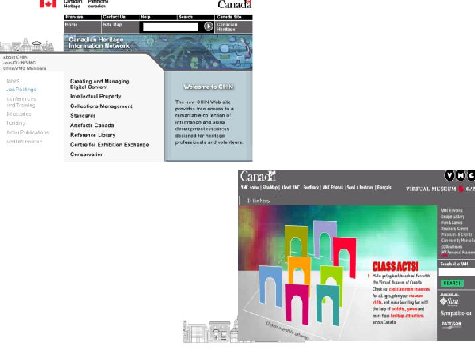
In support of CHINís mission, two websites help us:

CHIN ensures the coherence of its information resources by providing access to data in a standard format
As a disseminator of heritage information, CHIN promotes mapping procedures for information exchange in its data collection practices
CHIN products "shell" with museum information
Databases include:
CHIN provides:
Integrated access to distributed heritage information

Data dictionaries: Primarily created as a reference tool for users of CMS for CHIN when we did CMS - defines the categories of info stored in CMS
Data dictionaries: One humanities, one nat sci, one arch sites - primarily to facilitate sharing and accessibility to information about collections in canadian museums
These fields, in turn, were mapped to DC for a project with CIMI. Consortium for Interchange of Museum Information We exported records in XML based on the mapping as a testbed project for interchange of museum info. We sent around 2000 museum records and 2500 records from CHINís guide to canadian museums and galleries. Product of this testbed project was CIMIís Guide to Best Practice for DC
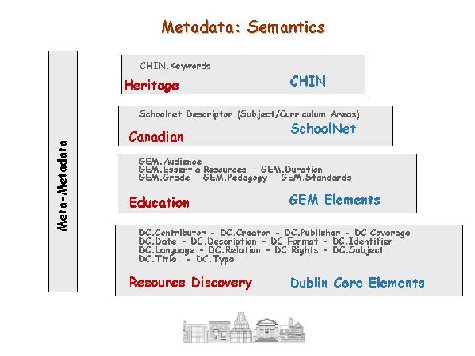
In 1999 developed an application to allow museum staff to easily create metadata for virtual exhibitions and related online resources
"Learning with Museums", an application on CHINís website, is an integrator for distributed, on-line educational materials, created by the Canadian museums, available for on-line information seekers.
The messages are meaningful to resource discoverers, seekers of educational on-line materials in general, Canadian materials,in particular, as they have elements based o Canadian subjects and curricula, reflecting the heritage aspect and museums authority and style.
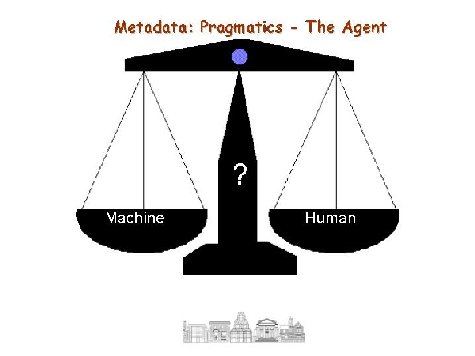
Who are we creating the metadata for? A machine? A human? We needed to create metadata that can be retrieved and understood by machines, but can be presented in a way meaningful for humans.
Similarly, we needed to make it easy for people to create metadata without needing to understand complex syntax. (let the machine do that work)
The MetaCollector toolkit has two main processes:
We looked at various metadata creation tools, but those available 1998/99 were few that did not fulfill our requirements.
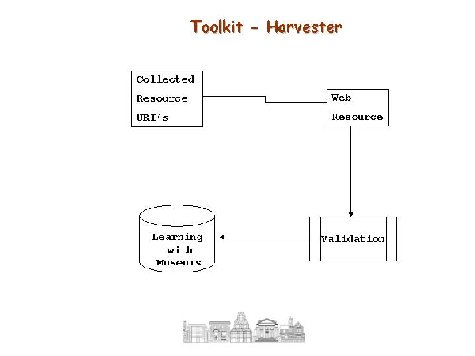
The role of the Harvester is to ensure the accuracy of the information presented to the users.
When we created the Cataloguing Tool, we were faced with several issues:
Interface - had to be simple, easy to use and available in a short form. Since each and every metadata element could be repeated any number of times, we did not want to impose a fixed number of occurrences but allow for maximum flexibility.
Elements - What elements should we make mandatory to satisfy basic searches?
Vocabulary - The educational world has its own vocabulary and we needed to borrow from that. We wanted to promote the use of standard terms when describing a resource and at the same time allow for evolution and expansion. The Cataloguing tool uses a mix of Mandatory, Suggested and Uncontrolled vocabularies. (free text)
Language - The toolkit is presently available in English and French and could be customized for other languages
Change Management - A resource does not have to be a static entity, it may evolve. The cataloguing tool should allow for changes to be easily incorporated. ** This is an area we need to review - change of metadata easy, but not for the URL.
Quality assurance - We wanted the information to be accurate. The use of controlled vocabulary and the mandatory fields bring a certain level of quality to the information collected. Also we needed to keep information about resources that were still available on the internet.
Expression - The tool had to generate standard Metadata HTML tags, and DC tags within an RDF envelope. What structure do we use? What standard do we follow? Those are some of the issues we had to deal with.
Change Management /Quality Assurance
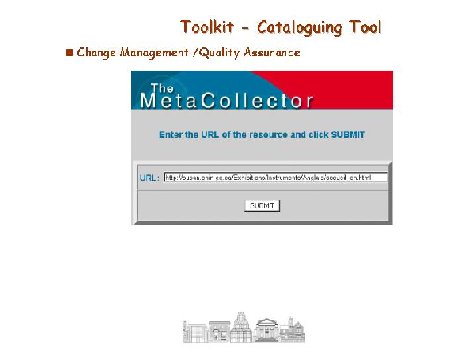
To catalog a resource you must provide a valid web address. Entering the Web address is the first step to cataloguing a resource. The URL is the unique key for the resource, and all metadata is associated with a particular URL. VMC resources must be catalogued in both official languages. (issue of separate URLs)
Because we are still experimenting with XML/RDF schemas and DTD's we had to come up with an easy way to make changes to the Metadata tags or the formats.
At first we planned to have the XML code reside in the resources themselves as part of an html page. When we realized that the probability of changes was fairly high we decided to keep all this information locally and have it referred to by a simple LINK tag in the resource. ** They are sent HTML tags (title, description, and keywords) - for search engine retrieval, and also sent a LINK tag that relates back to a URL at CHIn where the metadata resides.
Interface / Metadata Elements
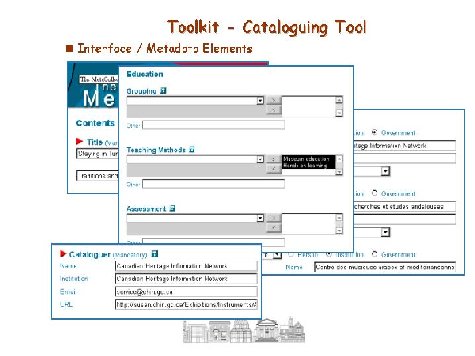
If we have a look at the form itself you will see that different display techniques were used depending on the element and also based on suggestions from our focus group.
For the Title we note that
- it is a mandatory field indicated by both the word (Mandatory) and by the red arrow.
- it is a repeatable element indicated by the + and - signs . When you click the +, a new entry box becomes available. When you click - the last entry box is removed.
- we also provide help at the element level; by clicking the ?.
As for the Agent :
- is is also repeatable but instead of being a single element, it is a group of elements that are being repeated. One can create any number of entries for Creator, Contributor and Publisher and each having their own sub-elements.
If we take a closer look at the some Education specific elements, Grouping tells about the type and size of the class, Teaching Methods : 2 examples are Museum Education and Hand-on Learning ; while the Assessment element represents the evaluation process of the activity of utilizing the resource
From the interface stand point, the greater than (>) button is used to move items picked from the drop down list to the selected box which is on the right. The less than (<) button will remove items from the selected list.
Another mandatory field is the Cataloguer, the person cataloguing the resource
Vocabulary / Language
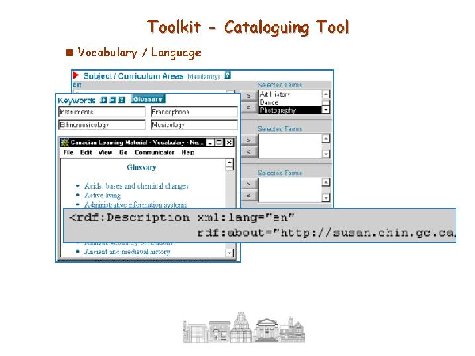
As mentioned earlier, three types of vocabularies are being used within this tool:
The language of the metadata (not the resource) is mentioned on the RDF statement and applies to all elements.
Expression
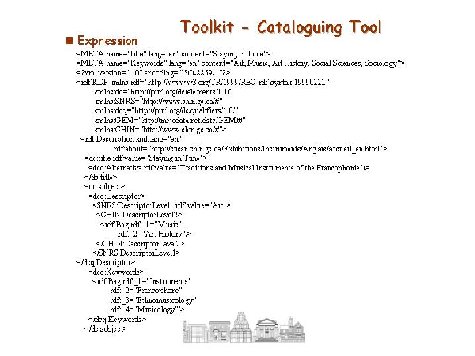
Here is an example of the kind of information we are taking about. It is a structure and format that CHIN has adopted based on researches, consultations and information that were available at the time.
We are already in the process of refining this information due to new developments in the XML/RDF world and also due to a better understanding of all these processes.
These are only the first three elements, so it is clear that this would have been a lot of metadata to ask people to put in the header of a resource.
|
Expression META name="title" lang="en" content="Staying in Tune" META name="Keywords" lang="en" content="Art, Music, Art History, Social Sciences, Sociology" ?xml version="1.0" encoding="ISO-8859-1"? rdf:RDF xmlns:rdf="http://www.w3.org/TR/1999/REC-rdf-syntax-19990222" xmlns:dc="http://purl.org/dc/elements/1.1/" xmlns:SNRS="http://www.chin.gc.ca/#" xmlns:dcq="http://purl.org/dc/qualifiers/1.0/" xmlns:GEM="http://metadata.net/dstc/GEM/#" xmlns:CHIN="http://www.chin.gc.ca/#" rdf:Description xml:lang="en" rdf:about= "http://susan.chin.gc.ca/Exhibitions/Instruments/Anglais/accueil_en.html" dc:title rdf:value="Staying in Tune" dcq:Alternative rdf:value= "Traditions and Musical Instruments of the Francophonie"/ /dc:title dc:subject dcq:Descriptor SNRS:DescriptorLevel1 rdf:value="Art" CHIN:DescriptorLevel2 rdf:Bag rdf:_1="Music" rdf:_2="Art History"/ /CHIN:DescriptorLevel2 /SNRS:DescriptorLevel1 /dcq:Descriptor dcq:Keywords rdf:Bag rdf:_1="Instruments" rdf:_2="Francophone" rdf:_3="Ethnomusicology" rdf:_4="Musicology"/ /dcq:Keywords /dc:subject |
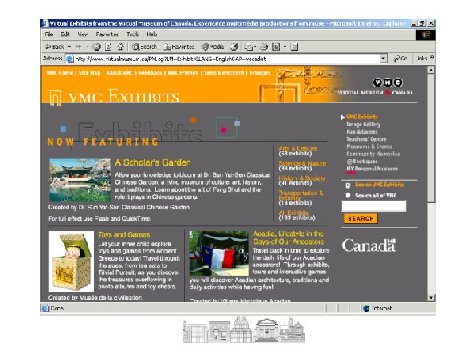
Metadata for "type" determines where on the VMC site the resource will display. Eg - "game" will result in resource displaying on the fun and games page
"Exhibition" will ensure resource displays on VMC exhibits.
If neither of these categories is chosen, they resource will still be displayed on the TC, if relevant search terms are chosen, or browsing resources in which this is categorized
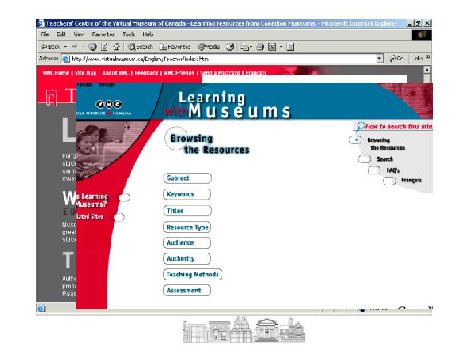
You can search for specific terms using the search form or browse the available listings under some of the elements to see what is available.

You can search for specific terms using the search form or browse the available listings under some of the elements to see what is available.
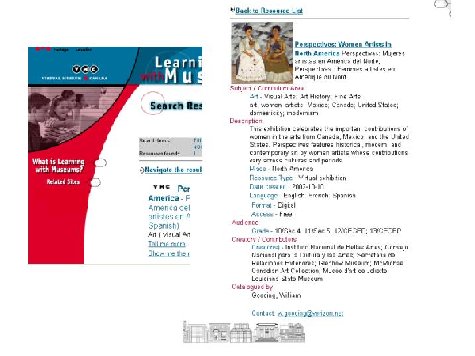
A search (or browse result) will initially present you with a brief record. At this point you can choose to view the full record or go directly to the resource.
A full record - Here is one of the challenges - having different people catalogue resources from different institutions. (museum staff)
Although we provide guidelines, not all resources are catalogued in a consistent manner. On this resource, alt titles for the different languages have been presented here. This is an area we need to rethink how do we represent alt languages and make a link between the linguistic versions of the site?

Strengthens the capacity of smaller museums to create content for the Web by supporting their development of online local history exhibits. Museums whose proposals are selected are supplied with user-friendly software and a standard investment of $5,000.
At the time of application, they fill in a form, and information from this form is entered in a database. At the exhibit level, some of this information is used to generate dublin core metadata. We wanted the 5 tags required by the government of canada and some additional tags.
That is, one can not go directly from an image in the IG to an exhibit. In CM, the images, when retrieved in a search are within their CM context.
Metadata associated with each VM as a whole
Landmarks
Exhibits - mapped to DC
| html tags | Field in DB |
| title | Production title |
| description | Production description |
| keywords | (Controlled vocabulary terms - 1st level only if nore than 20 terms) |
| author | Institution name |
| DC tags | Field in DB |
| dc.title | Production title |
| dc.creator | Institution name |
| dc.language | Language of proposal |
| dc.subject | Exhibit subject (Controlled vocabulary terms - 1st level only if more than 20 terms) |
| dc.date.created | Date CD Loaded to network? Yes |
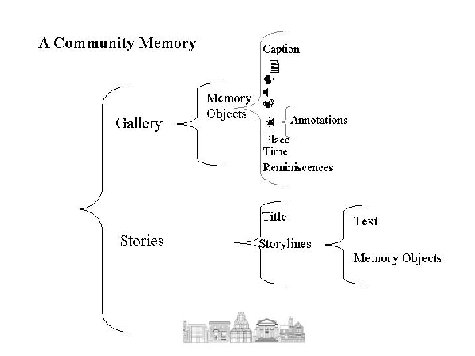
Top section, all pieces of information associated with a particular object. You may have an image, with a caption, there may be a audio reminiscence about the particular image, etc.
We also have stories within a CM, but they do not have the same relationships as seen above. Any image may be retrieved in a search that searches all the available CM exhibits. (community memory) When you choose to look at a particular image, however, you will be taken to it in its context. The metadata for the object has its context.
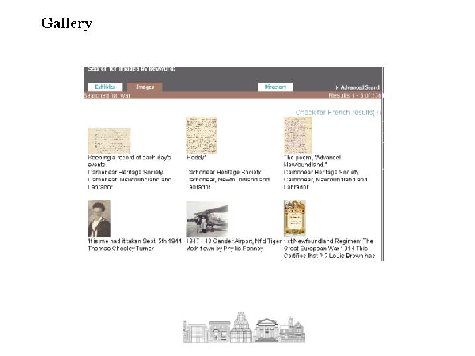
When you search for images, the images appear according to your search criteria, but once you select an image to look at, you get the image in its intended context, so we have kept the image in its context WITHIN the collection
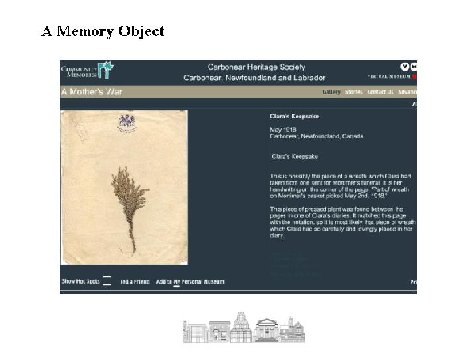
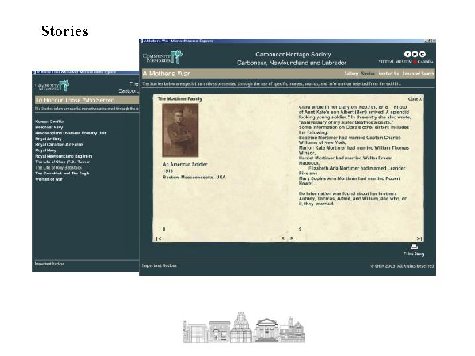
Simple search - for either exhibits or images. (toggle by the button above search bar) Advanced search by category only available for images.
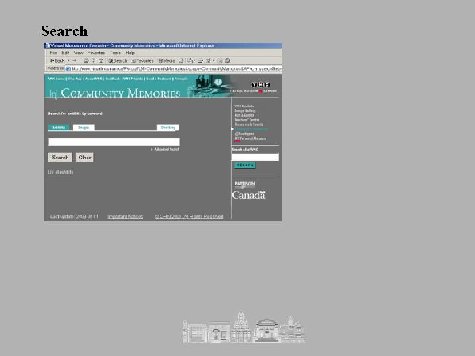
Flash version and non flash version. Browse by categories or search by choosing your own terms.

Categories at the object level - these were preconfigured by the software. For exhibits, we have not yet provided a mechanism to browse by categories, as we had in the initial pilot project 10 english and 10 french. Soon, however, we will have over 100 and will need to come up with categories to browse the exhibits as well. (here called advanced search)
Most obvious challenge - deal with cataloguing tool changes. We have learned a lot since 1998 /9 when we initially designed tool. We will revise the way we deal with some of the elements output.
Also need to deal with bilingual cataloguing better. In other products, people only use one form - fields that are pick lists are automatically translated behind the scenes and they only need to provide translation (where applicable) for free text fields.
Need to link LWM and CM, so that searching LWM will find CM records on that subject.
Also need to deal with preservation generally, and preservation metadata.
Sheila Carey - scarey@chin.gc.ca
Canadian Heritage Information Network
www.chin.gc.ca
Virtual Museum of Canada
www.virtualmuseum.ca